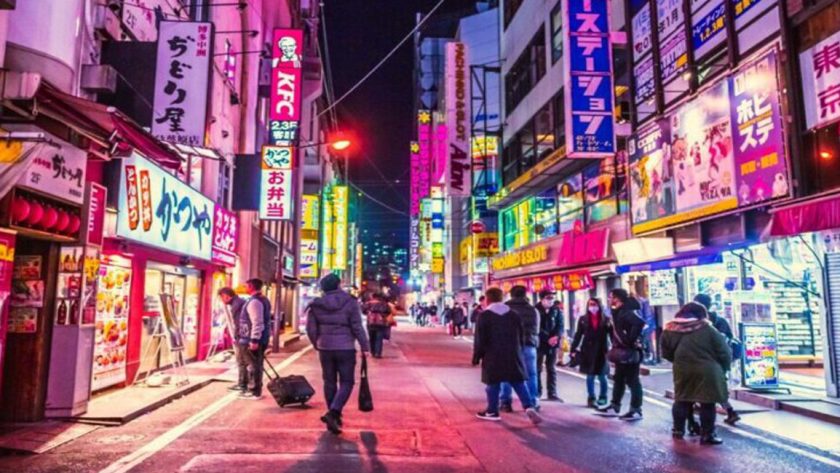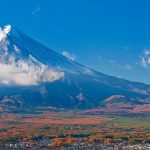Article and
I consider myself a big sports fan. I pore over the daily sports page, watch SportsCenter religiously, and follow each L.A. Dodgers baseball game as if a win is a chalk closer to the World Series and a loss is just a long trip back on the bus. So it was fitting that, through sports, I had my first introduction to Japanese culture. After only ten days in Japan, a country that can hold on to its past with ancient temples and traditions, yet blast forward with technology, it was my experience in the stands that brought me to a closer understanding of the culture. At my first Japanese baseball game, on a Friday night at the elaborate Tokyo Dome in the heart of the city, the Tokyo Ham Fighters were losing big to the visiting Blue Waves – and I was losing my misconception that all baseball fans are alike. In the first inning, the lead-off batter punched a foul ball down into the stands. In the States, if a foul ball comes anywhere within 50 yards of the crowd, the whole section lunges like determined bachelorettes vying for a wedding bouquet. In Japan, you only get the foul ball if it comes right to you. So when a foul ball was hit to an empty seat, the surrounding fans just watched as it bounced around and came to a stop. Eventually, a curious youngster would finally pick it up or the usher would retrieve it minutes later. None of the fans dared to leave their seats and get the ball, politeness taking precedence over fandom.
At the end of the seventh inning, a Japanese girl appeared with sashimi and beer on hand for the final innings. While I was enjoying the game just fine from my nosebleed seats, I decided that this girl would be just the person to provide me with more of a clue as to the rituals of the baseball game (also, she was really cute). I disguised myself as a professional photographer (it’s amazing what travel journalists get away with), and I got security to allow me to photograph just beyond the center-field fence. I took a few shots and then sat down next to Akima, fumbling for a new roll of film.
“Konichiwa,” I said with a smile. She simply smiled back.
“Gangi desu ka?” I added. How are you? She gave another nervous smile.
There was an uncomfortable lull and I knew that if I didn’t say something really funny, inspiring, or smart, she was going to have security separate us by three rows. I dug into my cargo pants for the invaluable Japanese phrasebook, opened to the first page I found, and blurted out “Do you like to ride bicycles?”
Akima’s nervous grin suddenly parted to show her pearly whites. She looked down at the book and asked in English, “Where do you get this stuff?” with a laugh. Somehow I had broken the language barrier.
For the rest of the game, using the phrase-book, we discussed each other’s favorite colors, favorite baseball players and favorite coffee before continuing onto Starbucks for two Green Lattes (this being Akima’s favorite). That phrase-book, in those first four days before I lost it, was a very useful tool.
I had so much fun at the game I thought I’d check out the other national pastime: Sumo Wrestling. I was really looking forward to this, mainly because of that old TIMEX commercial where the two sumo wrestlers strapped with watches slam into each other, proving the watch’s durability. However, the matches I saw were a bit of a disappointment. The rowdy crowd and the relentless body slamming I had imagined were replaced by quite a different experience.
The match took place in the Kokugikan, a sumo stadium, with a full crowd seated around the ring. The ringside spectators enjoyed small, square seating pads which three people could comfortably sit cross-legged, eat sushi, and drink sake. Those of us farther away simply sat side by side. The whole match was relatively quiet, with polite golf claps as the only cheering.
The match began when the two sikishis entered the ring and drank water handed over by the two opponents that had previously rumbled. Then they entered the doyo, a fifteen-foot-diameter ring of sand. What made the ring really interesting was that just beyond it was a three-foot embankment, where members of the audience were sitting.
When the wrestlers enter the ring, they first place their hands on their thighs and then elevate each leg so that it is parallel to their hip. Each competitor then throws white salt into the ring for luck. Just when you think the rumble is about to begin, they stand up, walk back and start the process all over again. This ritual takes place three times before they even wrestle, and then finally the two competitors lunge at each other, attempting to push each other over. Waiting the five minutes through these rituals only to see a five-second duel got old really fast. The only exciting part was when a wrestler got thrown down the embankments to the fans below. But even that wasn’t enough to completely win me over. Leaving, I saw something that would never happen in America. The giant sumo wrestlers leaving the arena were completely unprotected from the crowds. There were no fences, security guards, or mobs of people clawing for autographs. In fact, when Musashimaru, the yokozuna, or grand champion, entered into the public, the crowd parted like the Red Sea. Musashimaru is one big man (sumo wrestlers can weigh up to 600 pounds), but I know for sure that Shaquille O’Neal can’t just walk around the Staples Center in Los Angeles after a big win without getting mobbed. In Japan, Musashimaru does.
I eventually decided that baseball in Japan, not sumo wrestling, was where the real fun was at. I had such a good time at the first game that I thought I’d catch one more before heading home (I already mentioned that I’m a huge fan, right?). Baseball was brought to Japan in 1905 from the States. There are only a few things about Japanese baseball that are different from the U.S. games. The ball is smaller and the batter’s swing techniques vary but the most noticeable difference is the fans. When it comes to the people in the stands, well. . . it’s a whole new ball game.
The fans definitely make the baseball experience. For one, they sing throughout the entire game. I don’t mean just random shouts of support or rants of disgust at the umpire. I’m talking about organized, customized cheers for each player, complete with a horn assortment, gigantic flags, and, of course, clapping leaders. At any given game, four of these clapping leaders stand on small stools with white gloves and a whistle. On cue, they begin exaggerated clapping, the horn section starts playing, the flags start waving, and they begin one of at least 100 customized cheers that last the entire game with the crowd joining in.
After the fifth-inning, in the only English I heard during the game, the public announcer boomed, “Stand up for the Fifth-Inning Celebration!” Suddenly, cheerleaders were cartwheeling on the infield, the Ham Fighter mascots (think Gonzo from the Muppets) were break-dancing at home plate and the security guards next to me were waving pom-poms to the tune of “YMCA.”
Fifth-inning celebration aside, I’d have to say that my favorite part of the Japanese baseball experience is the beer, and I’m not talking Sapporo. In the U.S., buying beer at the stadium is usually an exercise in long lines, inflated prices, and a server with a hairnet and missing teeth. In Japan, you stay right in your seat while the prettiest Japanese girl you’ve ever seen comes up to you with a keg on her back and the tap in her hand. Yes, it will cost you 800 yen ($7), but her smile? Priceless.
As I write this, the Marlins and Yankees are battling it out in the 100th World Series. The Marlins are up 3-1 with a man on first in the bottom of the fourth. Even though I’m not there, I can sense the energy in the Pro Player Stadium in Miami as the Marlins try to hold off the Bronx Bombers. I can hear fans hanging on every pitch, yelling at the ump, lunging for foul balls to give their kids, drinking beer, eating hot dogs with mustard, ketchup, onions, relish. The works.
Also tonight, the Hanshin Tigers are battling the Fukuoka Daiei Hawks for the Nippon Series in Japan. It’s their World Series, and the duel is just as intense. The Tigers, down two games to zero in a seven-game series, fell behind 1-0 until Kanemato hit a solo home run to center to tie the game. In the bottom of the 10th, with bases loaded and one out, Fujimoto hit a fly ball to center deep enough to score Arias from third, and Hanshin took the win. That game is 13,000 miles from here, but I can also sense the energy of tens of thousands of fans going crazy in a whole different way. As each batter comes to plate, his cheering fans back him up with an orchestrated horn ensemble and singing. Hundreds of flags wave through the outfield, fans stand up, sit down, and raise their fists in unison to cheer for a hit, drinking Asahi, eating sashimi, wasabi, pickled ginger, seaweed. The works.
Things to see and do in Japan
Mt. Fuji and Geisha girls are the first things that pop into most minds for Japan. Mt. Fuji was a bit out of my way this trip, but visiting Kyoto and checking out the Shogun palaces and seeing Geisha girls was a definite a possibility.
Kyoto The capital of the Shogun era was the cultural hub of these local leaders. Visit one of the many temples built for the multiple rulers that lived here and fought against each other. Temples are everywhere in Kyoto and the walks are just as exhilarating as seeing the temples themselves. Kyoto is also the home of the Geisha girls, young ladies that train for years to entertain guests in music, dance and song at the high end restaurants in town. You can also meet them at Starbucks as my guide Ryoto and I did.
My guide in Kyoto was Rio, a 20 year old volunteer student from the local college, who has led photographers and writers from magazines like National Geographic around the city. Although torrential downpours put a damper on seeing too many palaces that day. So over lunch, we started to talk about the mystique and rock star status of the Geisha girl.
Geisha girls are women who are trained to perform traditional dance, music, at the finest restaurants in Kyoto. Their place in Japanese culture goes back hundreds of years. But again, the Geishas are mysterious. They are wrapped around so much tradition and priority to entertain in the finest of restaurants, that there was no chance to hang out with them.
So to my surprise, Rio and I saw two geishas drinking their carmel macchiatos in the corner of the Starbucks adjacent one of the palaces. It was a moment where the cultures of thousands of years (the Geisha mystique, the shogun palaces) were now intertwined with a Starbucks on the opposite corner where they all hung out. The two were just finishing up, and Rio and I insisted we buy them a second round, but work was calling and they posed for a quick photo and said goodbye
Other charms of Japan
Kobe: Unfortunately famous for the devastating earthquake in the early 90’s, this quaint town on the west side of Japan is known for its natural hot springs, incredible steaks, and the home of sake. Kobe is a place where you take a vacation from your vacation.
Hiroshima Is not an easy city to visit being an American, but I found the locals to be gracious despite our past. The Peace Park is a memorial to the 100,000 plus that died from the A bomb and has vivid accounts and symbols in hopes it never happens again. However, Hiroshima is not just a city with a memorial. There are a number of attractions including shopping, baseball, ferries, and clubs. A short ferry away is Myojima, an island teaming monkeys, temples, and beautiful views.



